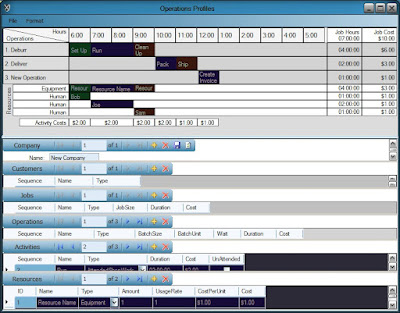The primary purpose of Pragma is two-fold: Analysis of time and costs, and Automation of information processing.
1. Provide businesses with tools for analyzing costs and time frames for operations.
The Problem: Many business owners are not accountants – rather, they are experts in the operations of their business. Often, they are skilled tradesmen who have made the transition to entrepreneurship in their industry.
Setting prices for products and services, determining the feasibility of new equipment purchases and other expense decisions requires this analysis of costs, but it is not as simple as it may seem. Many decisions about cost allocations should be made by an accountant, and are based on many considerations that are important, but will always remain in the domain of accounting.
But until the method of allocation is determined, how do you know what to charge a customer for the use of your shiny new equipment? That presents a problem that is unfortunately a significant barrier – it is a barrier to entry into business, and also a barrier to successful business operation.
The problem of cost allocations is just one part of the barrier to entry to business that every potential business owner faces. The first order of the day is to produce a business plan, including a pro forma cash flow projection and operations plan. The cost allocation question is crucial to accurate cash flow projection, so without some way to handle this problem the barrier is quite high.
The Pragma Solution: The central focus of Pragma is time and cost information in the context of production operations. It provides a platform for break-even analysis and price determination, as well as operations management and scheduling.
Another way to describe Pragma is the gap that it fills: Typically, basic Customer information and detailed accounting ledgers are maintained by every company. But everything the company actually does is between these two information domains – the external sales list and deep internal books.
Operations management is key to your success, and Pragma works to give you a coherent basis of information from which to draw for operational decision making.
When the costs are gathered, the work of crunching the numbers and presenting an operations time and cost profile is handled by Pragma.
Pragma does not reinvent the wheel. It pulls data from existing sources, especially the QuickBooks accounting package. It sends scheduling data to calendar programs such as Google Calendar. It does not implement an internal relational database, but can be mapped to read any available data sources. And with access to these data sources, it can be configured to maintain the consistency between different databases and other information stores.
2. Automate the flow of information and document preparation related to operations.
Most operations settings are the source of information for billable activities. A typical scenario is that the operations department sends a spreadsheet with job completion data over to accounting for invoice processing. While it is possible to pull that data into QuickBooks automatically, many users do not have the skill to perform this task reliably enough, so they end up manually re-entering the invoices. Of all the things that have to get done one way or the other, this is at the top of the list.
Pragma provides a platform not only for integrating existing data such as QuickBooks transaction records, but also for automating the exchange of information between systems, and the automatic processing of redundant information-related processes. QuickBooks touts the phrase “Never Enter Data Twice (NED2)” -- and they have done an enormous amount of work to ensure that this promise can be fulfilled by any good programmer.
Leveraging the analysis of operations against QuickBooks features, it is very feasible to build a information-process automation platform within the Pragma framework.
Similar scenarios include production routers and job travelers, inventory checklists, labels, and tags, and virtually any other document type that derives from the various data sources in the system.
Here are some feature lists:
Pragma Performance Features
- Time and Cost Analysis for Business Operations
- Automation of Information Processing related to Ops (Estimating, Invoicing, Purchasing, Inventory Management)
- Produce Production floor routers and traveler with Operations profiles
- Generate Inventory Management documents: Checklists, labels, and materials tags
- Automate most QuickBooks features (they must be customized – not a catchall!)
- Tie Operations data to QuickBooks Estimates for use as Job Templates, and to Invoices for automatic invoice preparation
- Integration with Existing Data Systems
- Example: Complete Operations descriptions tie to Billable Line Items in QuickBooks
- Jobs are made up of one or more Operations (QuickBooks Customer:Job list and Estimates)
- Operations are divided into Activities, or process steps (One Op per QB line item)
- Activities are assigned the Resources they use (Can be QB line sub-items, even if not charged):
- Equipment (pulled from QuickBooks Fixed Asset Items list)
- Humans (pulled from QB Employee data)
- Plant facilities (depends on the plant – probably managed by Ops)
- Direct and Indirect Materials (Inventory and Non-Inventory Items in QB)
- Whatever (Generic Items)
- Resources costs are based on resource type
- Equipment is allocated a portion of depreciation expense or a rate based on replacement value
- Disposable material costs are transferred whole
- Reusable materials are assigned a usage rate
- Payroll costs are assigned directly or allocated based on attention (unattended vs. attended operation steps)
Pragma Design Features
- Runs as a stand-alone application or integrated middleware.
- Coordinates information from existing databases and QuickBooks accounting data, especially Customer and Job lists and Resource costs (QuickBooks Fixed Asset and transaction Items).
- Based on a Business Objects layer that propagates time and cost information throughout the system based on single input sources, either from existing data stores or user entry.
- Integrates with Google Calendar or Outlook for scheduling operations.
- Developed in VB.NET on Windows XP, Visual Studio Professional 2005, .NET 2.0

